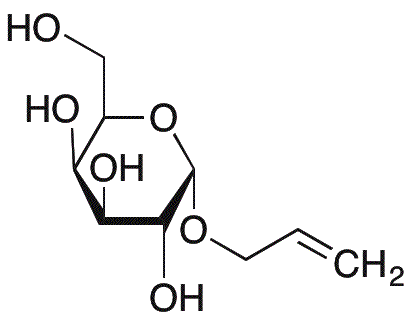Allyl a-D-galactopyranoside is widely utilized in research focused on:
- Glycosylation Reactions: This compound serves as a glycosyl donor in synthetic carbohydrate chemistry, enabling the formation of complex glycosides that are essential in drug development and biochemistry.
- Bioconjugation: It is employed in bioconjugation processes to attach sugars to proteins, enhancing their stability and functionality, which is particularly valuable in the pharmaceutical industry.
- Research in Immunology: The compound is used to study carbohydrate-protein interactions, providing insights into immune responses and potential vaccine development.
- Food Industry Applications: It can be utilized as a flavoring agent or sweetener in food products, offering a natural alternative to synthetic sweeteners with potential health benefits.
- Development of Antiviral Agents: Researchers are exploring its potential in the synthesis of antiviral compounds, contributing to the fight against viral infections.
General Information
Properties
Safety and Regulations
Applications
Allyl a-D-galactopyranoside is widely utilized in research focused on:
- Glycosylation Reactions: This compound serves as a glycosyl donor in synthetic carbohydrate chemistry, enabling the formation of complex glycosides that are essential in drug development and biochemistry.
- Bioconjugation: It is employed in bioconjugation processes to attach sugars to proteins, enhancing their stability and functionality, which is particularly valuable in the pharmaceutical industry.
- Research in Immunology: The compound is used to study carbohydrate-protein interactions, providing insights into immune responses and potential vaccine development.
- Food Industry Applications: It can be utilized as a flavoring agent or sweetener in food products, offering a natural alternative to synthetic sweeteners with potential health benefits.
- Development of Antiviral Agents: Researchers are exploring its potential in the synthesis of antiviral compounds, contributing to the fight against viral infections.
Documents
Safety Data Sheets (SDS)
The SDS provides comprehensive safety information on handling, storage, and disposal of the product.
Product Specification (PS)
The PS provides a comprehensive breakdown of the product’s properties, including chemical composition, physical state, purity, and storage requirements. It also details acceptable quality ranges and the product's intended applications.
Certificates of Analysis (COA)
Search for Certificates of Analysis (COA) by entering the products Lot Number. Lot and Batch Numbers can be found on a product’s label following the words ‘Lot’ or ‘Batch’.
*Catalog Number
*Lot Number
Certificates Of Origin (COO)
This COO confirms the country where the product was manufactured, and also details the materials and components used in it and whether it is derived from natural, synthetic, or other specific sources. This certificate may be required for customs, trade, and regulatory compliance.
*Catalog Number
*Lot Number
Safety Data Sheets (SDS)
The SDS provides comprehensive safety information on handling, storage, and disposal of the product.
DownloadProduct Specification (PS)
The PS provides a comprehensive breakdown of the product’s properties, including chemical composition, physical state, purity, and storage requirements. It also details acceptable quality ranges and the product's intended applications.
DownloadCertificates of Analysis (COA)
Search for Certificates of Analysis (COA) by entering the products Lot Number. Lot and Batch Numbers can be found on a product’s label following the words ‘Lot’ or ‘Batch’.
*Catalog Number
*Lot Number
Certificates Of Origin (COO)
This COO confirms the country where the product was manufactured, and also details the materials and components used in it and whether it is derived from natural, synthetic, or other specific sources. This certificate may be required for customs, trade, and regulatory compliance.


